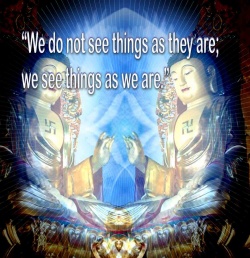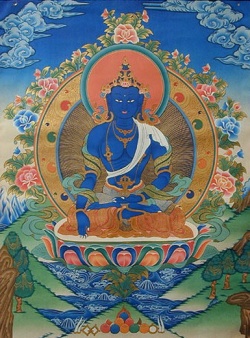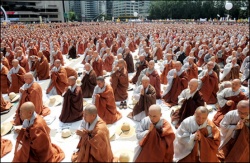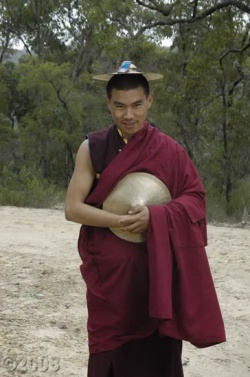Sarma lineages
The Sarma traditions of Tibetan Buddhism originated during the late 10th century. The various cycles of tantras, commentaries, and meditation guidance texts that were translated during this later dissemination (phyi dar) of Buddhism in Tibet are known as the "New" traditions. Two centuries later, Sarma-pa divided into the Sakya-pa and the Kagyu-pa. Three hundred years later, one of Tibet's revered lamas, Tsong-kha-pa, founded the reforming Gelug-pa. Although there were a great variety of Buddhist traditions that took shape in Tibet from the 10th through the 13th century, the 4 primary later or new translation period traditions are:
Sakya (sa skya)
Kagyu (bka' brgyud)
Jonang (jo nang)
Geluk (dge lugs)
Sakya Monastery was established in the year 1073 by Kontan Konchok Gyalpo (1034-1102), making it the earliest of these four Sarma traditions. Milarepa's (1040-1123) close disciple Gampopa (1079-1153) later founded Gampo Mountain Monastery, commencing the Kagyu tradition in the year 1121. Then, in 1294, Kunpang Thukje Tsondru (1243-1313) arrived in Jomonang, giving rise to the Jonang tradition. More than a century later, in 1407, Je Tsongkhapa Lozang Drakpa (1357-1419) reinterpreted the existing Kadam tradition and founded Ganden Monastery in the highlands of Central Tibet, initiating what is today known as the Geluk.
In addition to the Nyingma and the 4 major surviving Sarma traditions, there were minor practice lineages such as:
Zhalu (zhwa lu)
Orgyen (o rgyan)
Bodong (bo sdong)
Kadam (bka' gdams)
While these and numerous other traditions existed in Tibet during the later translation period, many of these early practice lineages of Buddhism did not survive as autonomous traditions in Tibet. Although some such as the Zhalu and Bodongpa have survived in isolated cases, most of the guidance texts and meditation techniques from these minor traditions were assimilated into and preserved by the 4 major living Sarma traditions of Tibetan Buddhism.
There are numerous New (Sarma) lineages and varying forms of practice that span all four tantric classifications as well as uncounted old oral traditions (Kama) and Treasure (Terma) traditions from the Nyingmapa School.
A traditional yet simple method of categorizing and cataloging the various Tibetan Religious Schools (Traditions) is to divide them into the Old (Nyingma) and New (Sarma) Schools. The Old refers to the early Buddhist teachings of Tibet that began during the time of Trisong Detsen, Shantarakshita and Padmasambhava in the 8th century. The New refers to the teachings that entered Tibet in the 10th century with teachers such as Rinchen Zangpo, Atisha, Gayadhara, Drogmi Lotsawa, Marpa Lotsawa and others.
The New Schools are generally listed as Kadam, Sakya, Marpa Kagyu, Shangpa Kagyu, Jonang and Gelug. There are of course many minor traditions and lineages of teachings. The Kadam School was later absorbed into the Kagyu and Sakya traditions and then later into the Gelug. Today the New Schools are popularly counted as the Sakya, Kagyu and Gelug. The Nyingma stands alone as the only Old School.
Together these four:
[1] Nyingma.
[2] Sakya,
[3] Kagyu and
[4] Gelug are popularly known as the Four Buddhist Schools (or Traditions) of Tibet.
The Three Principal New Schools:
Sakya
Kagyu
Gelug
All New Schools & Lineages That Stand Apart:
Bodong
Cho & Zhije
Drigung Kagyu
Drugpa Kagyu
Drugpa Kagyu (Bhutan)
Dzongpa (Gongkar), Sakya
Gelug
Jonang
Kadam
Karma Kagyu
Ngor, Sakya
Sakya
Shalu/Bulug
Shangpa Kagyu
Tsar, Sakya
Taglung Kagyu
Zhije & Cho



